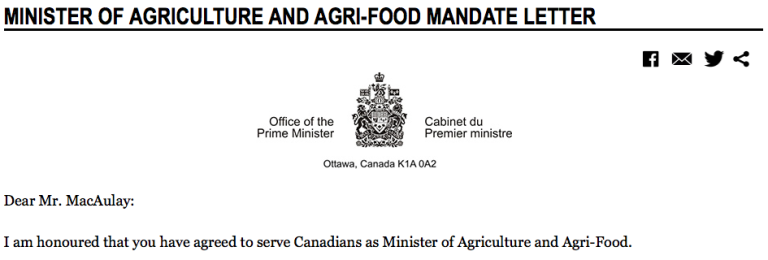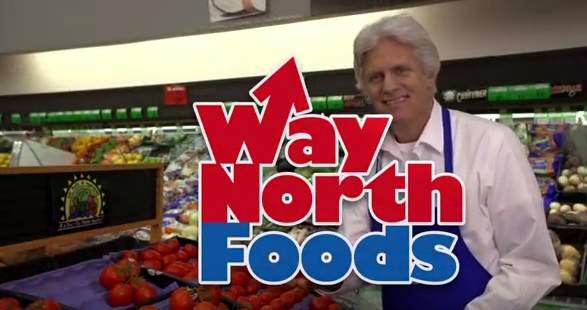Like this article? rabble is reader-supported journalism. Chip in to keep stories like these coming.
In the wake of newly resurgent Nunavut supermarket prices, a viral parody video campaign in support of Northern food security has garnered both domestic and foreign headlines. Yet despite renewed calls to revamp Nutrition North — the federal food subsidy program — and Prime Minister Justin Trudeau’s recent visit to Iqaluit, enduring pathways to food security in Nunavut remain unclear.
The parody campaign, developed independently by Calgary creative agency Wax in consultation with the Facebook advocacy group Feeding my Family, depicts a fictitious supermarket, “Way North Foods.” Happy Way North employees stand in gleaming aisles boasting massive weekly price increases, all grounded in catchy jingles.
“Nobody offers you less for more!” boasts one commercial, while another flashes flyer-style price changes “to take a huge bite out of your budget,” such as this two-pack of steaks, happily hiked from 14.38 to 72.99.

With over 35,000 views and a robust social media campaign geared toward policymakers and public figures, the videos sparked renewed, if brief, public attention towards the longstanding food security crisis in Nunavut calling for supporters to #endthepricehike.
“What hooked us, as outsiders, was the high prices,” said Christopher Lihou, the copywriter who helped spearhead the campaign. Lihou said his agency was moved by the food crisis in Nunavut and decided to reach out to Leesee Papatsie, founder of Feeding My Family advocacy group, to collaborate pro-bono on a simple messaging campaign geared to non-Northerners.
“Despite layers and layers of complexity to this issue, which we uncovered as we went along, we had to go about it the most simple way we could,” recalls Lihou.
High food prices across Canada spark solidarity
Long-heralded food price increases began to be felt Canada-wide in late 2015, symbolized by the $7 cauliflower so often immortalized on social platforms. Social photos of supermarket price tags during that time was Southern Canada’s echo, in small part, to Northern shoppers’ years-long online advocacy. Those visceral photos led to renewed policy interest south of Nunavut, and the recent ones might have created a ripe environment for the release of the Way North Foods parodies.
“The first response was really positive,” recalls Lihou. “We started developing it further and it really spread.”
The videos did hit a nerve. They sparked stories on national outlets including CBC, CTV & Global and international outlet Adweek.
Taye Newman, founder of the online resource Feeding Nunavut knows just how hard it can be to keep mainstream interest on the topic south of Nunavut.
“The response was overwhelming. Social media was a buzz,” she said, noting “hundreds of new members” on the ever-active Feeding my Family Facebook group and the influx of new visitors to Feeding Nunavut.
Trudeau pledges to prioritize food security
The #endthepricehike campaign was slated for release in the wake of the 2015 federal elections. The newly elected Liberal government pledged to prioritize national food policy, specified in the mandate letter for incoming Agriculture & Agri-Food Minister Laurence MacAuley.

In the letter, Trudeau also states, “No relationship is more important to me and to Canada than the one with Indigenous Peoples. It is time for a renewed, nation-to-nation relationship with Indigenous Peoples, based on recognition of rights, respect, co-operation, and partnership.”
Yet the specific release of the parody video was perhaps even more fortuitious, just as prices in Nunavut hit all-time highs and weeks before Trudeau’s visit to Iqaluit to discuss pressing issues for the region.
Leesee Papatsie says she was optimistic that the campaign incited more people to talk about the issue. “Once more people talk about it, there will be awareness and the more awareness, this can lead to action.”
“Northern consumers seemed to appreciate that the story of incredibly high grocery prices was being told,” added Newman, though she noted, “Northern grocery retailers were not as impressed with the campaign. Initially I think it was interpreted by some retailers as an accusation that they are taking advantage and price gouging northern consumers. In the end, the campaign became an opportunity for retailers to talk about the incredibly high costs of running a business in the north.”
Charged with federal policy surrounding the issue, the Ministry of Agriculture & Agri-Food said they were preparing to address the price hikes, said one spokesperson for Minister Laurence Macaulay. By the time of publication, we had not yet received comment from the Ministry.
Reaction: “How can we help?” or “Not my problem”
Limou says he continues to reach out to policymakers via social media, hoping they’ll watch the videos or even share the links.
“Hopefully people will use this as a gateway to get into the issues,” he said.
Yet despite renewed calls for a national food policy, many said the campaign also illustrated how the complex Nunavut food security crisis remains remote to many Southern Canadians.
“It’s a divisive issue,” noted Lihou, who echoed comments from Papatsie last year, said he had to deal with blowback or outright dismissal to the issue in social media discourse.
“We’ve got this difficult issue into the mainstream media, which is good. Though there were sort of two polar opposite reactions,” he said, “On the one hand, reaction of shock at the state of affairs, how this could possibly happen, how they could help.”
“On the other, many said this was ‘not our problem,’ that people should grow their own food, or that ‘people up there should move.'”
Newman has seen the gamut of quickfire responses and fixes to the food crisis, and hopes the campaign instead sparks long term change
“I’m hopeful that these new visits translated into many letters being written to Members of Parliament to ask that more be done for the north. I’m also hopeful that many people realize the challenge of feeding a family in the North and donated directly to a northern emergency food relief program. There are many northern food banks and soup kitchens that struggle to receive donations. Even school meal programs appreciate extra dollars to better meet the nutritional needs of children.”
Focus on traditional combined with Western ways
In addition to seeking more support for a Nutrition North revamp, Papatsie reprised her call for a holistic blend of efficient solutions:
“I’d also like to see support for finding ways to support hunters, seamstress, carvers and so on, supporting the people on the ground, doing a study in the north to find out what can be harvested at certain time of the year and finding ways to commercialize those.”
For those who struggle with the daily grind of procuring food for their, the ultimate effect of the campaign remains to be seen.
“I would like to see Northerners stand up to this, we Inuit are adaptable people, resilience people as well, we can learn to figure out how to work this out. It will take time but we can learn,” said Papatsie.
“Don’t forget, we are new to this type of world, Internet, formal education, workforce, this is all relatively new to us, we have to find a ways to work this out, using Western and traditional ways combined.”



